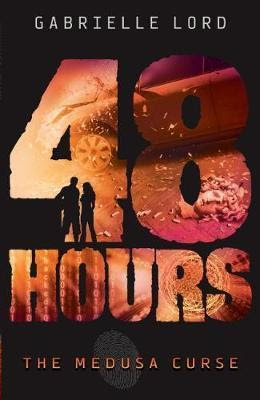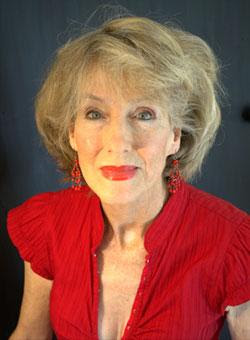Title of the work
Country of the First Edition
Country/countries of popularity
Original Language
First Edition Date
First Edition Details
Gabrielle Lord, 48 Hours #2: The Medusa Curse. Lindfield: Scholastic Australia, 2018, 235 pp.
ISBN
Available Onllne
Available for purchase (eBook) on goodreads.com (accessed: October 7, 2021).
Genre
Novels
Thrillers Fiction
Target Audience
Crossover
Cover

From 48 Hours: The Medusa Curse by Gabrielle Lord.
Text copyright © Gabrielle Lord, 2018.
Illustration and design copyright © Scholastic Australia, 2018.
First published by Scholastic Australia, a division of Scholastic Australia Pty Limited, 2018.
Reproduced by permission of Scholastic Australia Pty Limited.
Author of the Entry:
Charlotte Farrell, University of New England, charlottefarrell@gmail.com
Peer-reviewer of the Entry:
Elizabeth Hale, University of New England, ehale@une.edu.au
Lisa Maurice, Bar-Ilan University, lisa.maurice@biu.ac.il

Photo by Borys Rudko, with permission of the author.
Gabrielle Lord
, b. 1946
(Author)
Gabrielle Lord (b. 1946) is a crime fiction writer born in Sydney. She studied Literature at the University of New England, Armidale. She is best known for her fiction for adults, as well as the Conspiracy 365 series for young adults that included seventeen novels total. In 2002 she received the Ned Kelly Award for Best Crime Novel for her book, Death Delights, and in 2003 was the joint winner of the Davitt Award for Best Crime Novel by an Australian woman for Baby did a bad bad thing.
Sources:
The Author's website (accessed: October 7, 2021).
Wikipedia (accessed: October 7, 2021).
Bio prepared by Charlotte Farrell, University of New England, charlottefarrell@gmail.com
Questionnaire
1. What drew you to writing/working with Classical Antiquity and what challenges did you face in selecting, representing, or adapting particular myths or stories?
When I was about seven or eight, I read the Greek myths and had to ask my mother what this strange word was: ocean I couldn’t ‘sound it out’. I loved that book and read and reread it. I haven’t used mythology really (apart from the Medusa myth in The Medusa Curse) except in a very general way. My 12 book series Conspiracy 365 relies on the hero’s journey – how the boy Cal must leave his mother, (like Theseus) discover what happened to his father and find out who he really is by book 12 all done in a contemporary setting and hidden under an action/thriller story.
2. Why do you think classical / ancient myths, history, and literature continue to resonate with young audiences?
I believe they contain certain central elements that are true such as the need for growth, as in the Theseus myth, the need to know the truth about oneself and the need to overcome obstacles that life throws at us without falling in a heap. We don’t have to clean out the Augean stables nor slay the Minataur, but every life contains hurdles that must be overcome if one is to gain maturity.
3. Do you have a background in classical education (Latin or Greek at school or classes at the University?) What sources are you using? Scholarly work? Wikipedia? Are there any books that made an impact on you in this respect?
Nothing formal. Just the amateur’s love of the subject. I have a large dictionary of myths which I can consult.
4. Did you think about how Classical Antiquity would translate for young readers, especially in Australia?
The great stories almost always contain mythic elements and there are only 8 different plots or so we’re told! Ringing the changes on these is what makes stories interesting and the myths contain everything possible: love, death, infidelity, revenge, apotheosis…
5. How concerned were you with ‘accuracy’ or ‘fidelity’ to the original (another way of saying that might be – that I think writers are often more ‘faithful’ to originals in adapting its spirit rather than being tied down at the level of detail – is this something you thought about)?
I’m not concerned by adherence to the myth – there are too many of them that have different personae involved.
6. Are you planning any further forays into classical material?
I’m having a Sabbatical from writing at the moment but who knows what the future holds?
Prepared by Charlotte Farrell, University of New England, charlottefarrell@gmail.com
Sequels, Prequels and Spin-offs
48 Hours is a two-part series created by Gabrielle Lord. The first book of the series, The Vanishing, was firstly published in 2017:
Gabrielle Lord, 48 Hours: The Vanishing, Lindfield: Scholastic Australia, 2017, 240 pp.
Summary
The second book in the two-part series, 48 Hours: The Medusa Curse is a young-adult fiction book by Australian crime-thriller novelist, Gabrielle Lord. The first book in the 48 Hours series, The Vanishing follows friends Jazz and Phoenix as they embark on rescuing their schoolmate, Anika, from being kidnapped. In the second book, they embark on another mission to solve a crime. This time, a robbery occurs at the beginning of the novel. Art forgeries, hacking, hidden tunnels, corrupt socialites, and teenagers’ ingenious scientific skills contribute to this novel’s fast-paced intrigue.
The Knowledge Institute is a new museum of uncertain financial status founded by Dr Zhang, the father of Jazz and Phoenix’s friend, Mack. The teenagers help out with exhibitions there, as they have a shared passion for the museum’s curatorial focus on pairing cutting-edge technology alongside antiquities. The exhibition, From Ancient Times to Future Worlds for which they are preparing at the beginning of the book is to feature the much talked about Sapphire computer. Its inventor, Sir Robert Grimshaw, claims that it has extraordinary technological capabilities beyond anything that has been seen before.
In the exhibition, Sapphire will be presented alongside the Grimshaw Medusa – an enormous and apparently cursed statue of the gorgon herself: that is, until Sapphire is dramatically stolen before opening night of the exhibition. In the chaos of the theft, Medusa topples and injures Sir Robert, after which the reader is introduced to a range of possible suspects for the crimes, and questions as to whether the statue wields magical powers. Mack pleads for Jazz and Phoenix to use their crime scene know-how (which, in referring to The Vanishing, the reader learns they demonstrated by rescuing Anika from a kidnapper) to find Dr Zhang who has disappeared after the robbery and becomes the police’s prime suspect.
Jazz knows that crucial evidence and the likelihood of solving a crime drastically decreases after 48 hours, hence the title of the series. Each chapter of The Medusa Curse is titled with a decreasing digital clockface countdown to solving the mystery within this timeframe, creating mounting suspense as the story unfolds. There is occasional use of illustrations throughout the book, too – maps of the museum, photos of microscopic evidence, screenshots of video news clips – that give it particular appeal to the young reader.
Jazz and Phoenix fearlessly face a range of challenging feats as they try desperately to solve the crime. Phoenix utilizes cutting-edge technology drawing on his own hacking skills, while Jazz employs more traditional methods such as paper rubbings, though she does make use of the CrimeScene app on her tablet. These complimentary digital and analog crime scene investigation tactics help Jazz and Phoenix find the truth behind the theft of Sapphire and the mysterious provenance of the Grimshaw Medusa. They discover that the items were stolen in order to be copied and sold on the black market by Sir Robert’s own son – socialite Toby Grimshaw – to pay off his gambling debts, along with notorious hacker, Delgado. A corrupt museum security guard, Sammy, assisted in organising the robbery, as well as a key figure in international art forgery based in France, Camille Wolf-Ferarri.
Jazz and Phoenix’s quest and brave actions propel the narrative forward at full speed as the 48-hour countdown comes to a climactic end. They solve the mystery with the help of their school friend, Mike, and prove that Dr Zhang was innocent. They rescue both the Sapphire computer and Grimshaw Medusa, and the exhibition triumphantly goes ahead. At the conclusion of 48 Hours: The Medusa Curse, the reader is eagerly poised for the next installment of Jazz and Phoenix’s crime-solving adventures.
Analysis
The relationships between modern technology and classical mythology are central to 48 Hours: The Medusa Curse. The mythological element of Medusa’s curse in the novel introduces questions for the young adult reader as to whether superstitions from ancient times or modern technology have more power, and the protagonists, Jazz and Phoenix, present two different perspectives which the reader may choose to side with.
Jazz is more interested in the Grimshaw Medusa statue than the Sapphire computer. It was not a goddess in Greek legend but a Gorgon, which, she explains to Phoenix is “a sort of monster” (p. 12). By having the Sapphire computer and the Medusa statue exhibited alongside each other, modern technology is presented as something that could potentially solve the mythological curse the statue brings. However, the book also questions whether the theft of the computer was brought about by the Medusa curse in the first place. Jazz elaborates that the statue was found near Naxos in the Greek isles, and that on the bottom of the sculpture is the ominous warning that if it is ever removed from Athena’s temple, catastrophe will ensue. Catastrophe is certainly what occurs in the book, beginning with the crime scene that occurs shortly after the novel begins. Jazz explains that anyone who makes eye contact with the statue will turn to stone, to which Phoenix quips is nonsense: he believes in modern technology, not superstitions about curses.
In one part of the book, Jazz sneaks into the museum after hours. She thinks that she sees the Medusa statue’s snake-like tendrils begin to move. Jazz later realises it was a black cat behind the statue, waving its tail. Themes of optical illusions, mythological curses, and the necessity for hard, scientific evidence are tensions woven throughout this novel, provoking questions for the young reader about where they may stand in relation to them.
Another mythological figure that appears in the book is that of Pan, the God of nature that takes a satyr form. A statue of him appears at the crime scene, and then again in Dr Zhang’s office. This becomes key to unlocking the mystery behind the art forgeries in the book, where replicas of the Pan statue (and others) have been illegally produced to be sold on the black market. Mythologically, the connection to the ‘panic’ that Pan could inspire in both mortals and Gods is present in 48 Hours: The Medusa Curse: When Jazz and Phoenix discover that the Pan statues have been copied, they become fearful of the implications of this discovery, and what it may mean for the missing Sapphire computer and Grimshaw Medusa.
Another mythological connection is that the trident that appears on a smashed piece of pottery at the crime scene – which we later discover is a casino chip from ‘Neptune’s’ casino belonging to Toby Grimshaw – serves an interesting link between the Medusa myth and her rape by Poseidon in Athena’s temple in Greek mythology. While the Medusa myth in particular is the foundation of much of the novel’s events, it serves more as a launching pad into a complex web of considerations about crime and scientific evidence in ways that are sure to engage technologically-savvy young readers.


